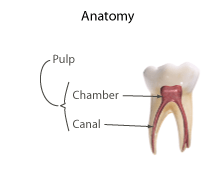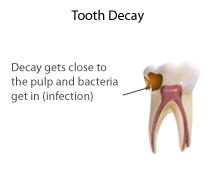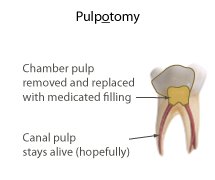Pulpotomy
A pulpotomy is the removal of a portion of the pulp, including the diseased aspect, with the intent of maintaining the vitality of the remaining pulpal tissue by means of a therapeutic dressing.[1] A healthy tooth has a space inside it called the "pulp space" which is filled with soft tissues - nerves, blood vessels, and pink connective tissue. When a carious process develops in a tooth, the bacteria associated with it can cause pulpal inflammation, which is often what causes toothache.

| Pulpotomy | |
|---|---|
| MeSH | D011672 |
Damage to the pulp of permanent teeth usually requires a root canal treatment or endodontic therapy. The pulp of primary or deciduous teeth, which only have to survive until an adult teeth come in, and because they have a better blood supply, can sometimes be saved.
Indications
Primary teeth
Primary/deciduous (baby) teeth in children have relatively large pulp spaces. Caries do not have to develop significantly before they reach the pulp chamber.

When the soft tissue in the pulp chamber is infected (has bacteria in it) or affected (is inflamed), it can be removed by a dentist or dental therapist under local anaesthetic. If the soft tissue in the canals is still healthy enough, a special medicated filling can be put into the chamber in an attempt to keep the remaining pulp (in the canals) alive. The process of removing the pulp from the chamber is the actual "pulpotomy", though the word is often used for the entire process including placement of the medication. There are many medicaments that can be used to fill the pulp chamber including zinc-oxide eugenol as well as mineral trioxide aggregate.
There are two types of pulpotomy techniques depending the extent of caries in a tooth and the symptoms it presents. A vital pulpotomy or a non-vital pulpotomy can be carried out. However, recent research shows that non-vital pulpotomies are rarely indicated due to their low success rates and it is therefore sometimes better to extract the tooth.

Afterwards the tooth is restored with a regular filling, either composite or amalgam, or a stainless steel crown. Due to the process of a pulpotomy causing the tooth to become slightly brittle, a stainless steel crown is normally indicated as the preferred choice of definitive restoration.
A pulpotomy can be done to both permanent and primary teeth.
Types
Partial Pulpotomy for Carious Exposures
In some cases, radicular pulp (pulp within the root of a tooth) may remain healthy despite carious exposure of the pulp chamber. In cases where root formation is incomplete (as during adolescent years), a partial pulpotomy may keep radicular pulp vital long enough to allow the roots to develop fully.[2]
Partial Pulpotomy for Traumatic Exposures
A partial pulpotomy for traumatic exposures is also called a Cvek Pulpotomy. When a baby tooth or young permanent tooth is traumatised - say, hitting your teeth on the handlebars of a bike - it can be broken in such a way that the pulp is exposed. Again, a partial pulpotomy may help it to finish developing and be saved.
Adult Pulpotomy
Adult pulpotomies are not as popular with dentists today as they were 100 years ago. Historically, traditional endodontia has been reported to be a more reliable treatment than pulpotomy techniques, based on the rate of saved teeth and the longevity of their preservation. However, new research is changing this view. The pulpotomy, as a therapeutic dental treatment, has a long history. It has been used for thousands of years.[3]
Medicaments
In primary teeth medicaments such as formocresol, mineral trioxide aggregate, zinc oxide eugenol and calcium hydroxide can be used in pulpotomy. Formocresol use has been questioned due to toxicity concerns.[4]
Ferric sulphate, sodium hypochlorite[5][6] or a local anaesthetic solution containing a vasoconstrictor agent can be used to arrest any bleeding from the pulp prior to the placement of medicament.
Calcium enriched mixtures have been used in permanent molar teeth with irreversible pulpitis showing positive outcomes.[7]
Alternative pulpotomy techniques
Electro-surgery pulpotomy
Also known as non-chemical devitalization. Its mechanism of action is the cauterization of the pulp tissue. It carburizes heat-denaturated pulp and bacterial contamination.
Laser pulpotomy
This technique overcomes histological effects of electro-surgery. It creates a superficial zone of coagulation or necrosis that remains compatible with the underlying tissue and isolates the pulp from vigorous effects of the sub-base.
Objectives
- Maintenance of radicular portion vitality.
- Post-op clinical and radiographic evaluation should show no complications such as pain, swelling, sinus presence internal resorption or abnormal canal calcification. Additionally, the formation of a radiolucency subjacent to the furcation in primary teeth can indicate failure.
- Neither breakdown of the supporting tissue, nor trauma to succedaneous teeth should be detected.
See also
References
- "pulpotomy". American Dental Association.
- "Guideline on Pulp Therapy for Primary and Immature Permanent Teeth" (PDF). Pediatric Dentistry. 38 (6): 280–288. October 2016. PMID 27931467.
- "Is It Time to Do Routine Adult Pulpotomies?". Chairside Magazine. Glidewell Laboratories. 7 (1).
- Godhi B, Sood PB, Sharma A (October 2011). "Effects of mineral trioxide aggregate and formocresol on vital pulp after pulpotomy of primary molars: An in vivo study". Contemporary Clinical Dentistry. 2 (4): 296–301. doi:10.4103/0976-237X.91792. PMC 3276856. PMID 22346156.
- Shabzendedar M, Mazhari F, Alami M, Talebi M (2013). "Sodium hypochlorite vs formocresol as pulpotomy medicaments in primary molars: 1-year follow-up". Pediatric Dentistry. 35 (4): 329–32. PMID 23930631.
- Al-Mutairi MA, Bawazir OA (March 2013). "Sodium hypochlorite versus Formocresol in primary molars pulpotomies: a randomized clinical trial". European Journal of Paediatric Dentistry. 14 (1): 33–6. PMID 23597217.
- Yazdani S, Jadidfard MP, Tahani B, Kazemian A, Dianat O, Alim Marvasti L (2014). "Health Technology Assessment of CEM Pulpotomy in Permanent Molars with Irreversible Pulpitis". Iranian Endodontic Journal. 9 (1): 23–9. PMC 3881298. PMID 24396372.
External links
- American Academy of Pediatric Dentistry website
- Markovic D, Zivojinovic V, Vucetic M (September 2005). "Evaluation of three pulpotomy medicaments in primary teeth". European Journal of Paediatric Dentistry. 6 (3): 133–8. PMID 16216093.